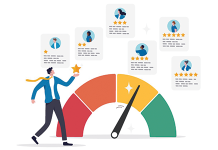In today’s rapidly evolving business environment, conventional sales engagement strategies are no longer enough to support B2B buying groups through their complex purchase journeys and deliver successful deals. Sales leaders must effectively integrate digital tools and seller interactions to provide a seamless, engaging buyer experience that drives confident decision making by enabling buyers to clarify their business goals, recognize value in their specific context, and establish buying group consensus.
Empower Buyers to Explore and Refine Their Business Goals
B2B purchases are frequently initiated by an internal change or requirement unique to the buying organization. However, buyers often require assistance in defining their business problem and identifying precisely what they need. One of the primary strategies for engaging reluctant buyers is to empower them through self-service digital content and tools to learn more about their challenge (or opportunity), and explore their business goals independently. By providing platforms where buyers can access information, compare options and evaluate solutions at their own pace, companies can create a more personalized and satisfying buying experience.
Optimize Touchpoints to Satisfy Buyers’ Learning Needs
Buyers today are inundated with information, making it essential for sales organizations to deliver relevant and concise content that addresses specific buyer concerns. Consequently, optimizing touchpoints to align with buyers’ learning needs is critical to successful engagement strategies.
Gartner data shows that buyers prefer self-service digital touchpoints to serve their general learning needs, but they lean on sellers and subject matter experts when their needs become more specific. By understanding the buyer’s purchase journey, sales leaders can identify how to deliver the right information at the right time to aid buyer decision making and facilitate smoother deal closure.
Embolden Buying Teams
Fostering confidence and consensus among buying teams is vital. In many organizations, purchase decisions are made collectively, requiring sellers to engage multiple stakeholders effectively. This necessitates a shift from traditional sales pitches to value-driven conversations that resonate with each stakeholder’s unique priorities and concerns. Sellers must be equipped with the skills to navigate these complex interactions, ensuring that all parties feel heard and valued.
Leverage Buyer Insights and Develop Seller Skills
The challenges faced by sales leaders today, such as prolonged sales cycles and difficulties in closing deals, underscore the need for an overhaul of sales engagement strategies. Mapping the buying journey is a critical step in this process. By identifying key decision points and potential obstacles, sellers can tailor their approach to address specific buyer needs and pain points. This proactive strategy not only enhances buyer engagement but also streamlines the sales process, reducing the time and effort required to close deals.
However, in isolation, buyer journey mapping is not enough. Sales organizations must combine this with advanced engagement analytics that provide valuable insights into buyer behavior, preferences and engagement levels. By leveraging these capabilities, sellers can make data-driven decisions, personalize interactions, and deliver targeted solutions that meet buyer expectations.
As the role of the seller evolves, so too must their capabilities. Training programs that focus on communication, empathy and problem-solving can equip sellers with the tools they need to succeed in today’s competitive market. By fostering a culture of continuous learning and development, organizations can ensure that their sales teams remain agile and responsive to changing buyer dynamics.
A Holistic Approach to Selling
Understanding buyer needs and providing relevant information are foundational to successful sales engagement strategies. Sellers must move beyond generic pitches and instead focus on delivering tailored solutions that address specific buyer challenges. This requires a deep understanding of the buyer’s industry, market trends and competitive landscape. By positioning themselves as trusted advisors, sellers can build credibility and trust, paving the way for more fruitful and enduring relationships.
The key to selling to reluctant buyers lies in a holistic approach that combines digital innovation with human interaction. By enabling buyers to self-serve, optimizing touchpoints, fostering confidence and integrating technology, sellers can create a compelling and engaging buying experience. As the sales landscape continues to evolve, those who adapt and embrace these strategies will be well-positioned to thrive in the face of increasing buyer expectations and market complexities.




